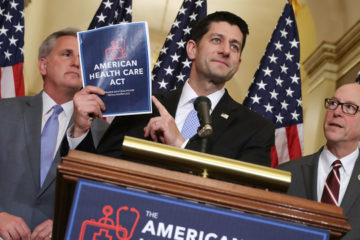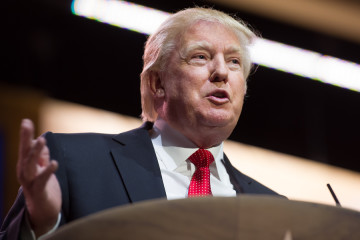The Anguish of Obamacare Didn’t Have to Happen: Megan McArdle

published Aug 29th 2016, 12:16 pm, by Megan McArdle
(Bloomberg View) —
The last few weeks have featured a great deal of news for Obamacare, most of it bad. Insurers are pulling out of the exchanges and premiums are rising. Coverage has been expanded, but it increasingly looks as if that coverage will mostly consist of companies taking their Medicaid managed care plans and repackaging them for private customers. Call it “Medicaid with premiums.” Or worse, that the exchanges will enter into a cycle of premiums rising and healthier customers dropping their insurance, until some markets have no insurance available at all.
QuickTake Obamacare, Assessed
Six and a half years into Obamacare, it seems worth asking, “Was this inevitable?” And, if so, “Was there a better alternative?”
I think the answer to the first question is “Yes.” And I think the answer to the second is, “Yes, there is something Washington could have done, and it probably would have been better than what it did.” I’m not talking about pie-in-the-sky reforms, like my proposal to replace all government health care with a progressive catastrophic government plan that covers all expenses that exceed a certain percentage of income.
I’m talking about something that President Barack Obama’s White House and a Democratic Congress could have enacted in 2010 that would have achieved comparable coverage at roughly comparable costs. Instead, they overreached, trying to gut-renovate the American health-care system even though they didn’t really have the political tools to get the job done.
But to explain why they should have done something else, I should first explain why I think that what we’re seeing now was predictable. The answer is that long before the exchanges opened, many critics warned that its weak mandate – the fines for failing to participate are modest — would result in rampant gaming of the system by people who signed up only when they got sick.
The weakness of the mandate, like other flaws in the law, was politically necessary because the law was already quite unpopular, and its supporters couldn’t afford to alienate a single other voter. So they passed what they could and hoped to fix it later. However, the unpopularity of the law meant that there was a strong risk that they wouldn’t be able to fix it later, and indeed that is where we now find ourselves.
I don’t mean to suggest that the law has been an utter failure by the standards of its architects. They have not achieved anything close to universal coverage, but they did manage to reduce the number of uninsured people by somewhere between a quarter and a third. However, I think that if they had been a little less stuck on the idea of attacking every problem at once, they might have passed a less ambitious plan that would nonetheless have expanded coverage substantially, with far fewer risks to either the system or the Democratic Party.
Here’s my radical plan: If the Obamacare exchanges are going to result in, at best, people being able to buy Medicaid-style plans with limited choices and benefits, then why not just eliminate the middleman and give them … Medicaid?
In 2013, the last year before Obamacare took full effect, there were approximately 42 million uninsured people in the country, according to the Census Bureau. A little over two-thirds of those people, about 28 million, had household incomes below 250 percent of the federal poverty line (this year, that’s about $60,000 for a family of four).
Those people account for the bulk of the coverage expansion that we’ve seen from the Affordable Care Act, partly because low-income people were more likely to be uninsured, but also because people under that line get enough subsidies to give them relatively comprehensive coverage at little or no cost. People who have to pay substantial premiums to get high-deductible insurance that covers only a limited number of doctors and hospitals have largely declined to buy exchange policies. But for people with incomes below 250 percent of the poverty line, Obamacare is a pretty good deal.
Now, a substantial minority of uninsured folks are illegal immigrants who wouldn’t have been eligible for insurance under any politically plausible program. But by my calculations, insuring the rest would result in roughly the same coverage improvement — about 5 percent of the American population — that we’ve seen since the Patient Protection and Affordable Care Act took effect.
What would this have cost? I did some admittedly rough calculations, using the Kaiser Family Foundation’s estimate that Medicaid spending on non-elderly, non-disabled people (the elderly and the disabled already get coverage) was $4,141 for adults and $2,492 for children. Children made up about 15 percent of the uninsured population in 2013, which gives us a total cost of about $90 billion a year.
That’s around what the Congressional Budget Office projects will be spent in 2016 on Medicaid and various exchange subsidies combined. And that assumes that every single person signed up who was eligible and uninsured in 2013 — that the number of uninsured wouldn’t have gone down at all as the economy improved and that the Supreme Court would not have intervened to allow states to opt out of the Medicaid expansion.
There are objections to this. One is simply that my calculations are rough, as indeed they are. Another is that this offers nothing to the middle class. Which is true — but Obamacare offers little to middle-class people now, and in fact, has angered a lot of them by cancelling their insurance and forcing them to buy something both more expensive and less generous. It looks to me as if Democrats could have gotten pretty much all of the effective benefit with a Medicaid expansion plus some sort of high-risk-pool program for the truly uninsurable, at a fairly comparable cost.
In fact, I might argue that the political calculus would have been easier for at least some sort of Medicaid expansion, even if a retreat to such a staid incrementalist goal would have been temporarily embarrassing for the Obama administration. Establishing a program, and then gradually expanding it, has long precedent in American politics. Social Security, for example, was transformed over decades into the system we know today from the comparatively bare-bones pension that President Franklin D. Roosevelt signed in the 1930s.
But if the CBO did a more thorough version of my rough calculations and came back with a number that made it too costly to include all those earning up to 250 percent of the poverty line, then the administration could have started smaller, insuring only those earning 200 percent of a poverty income, or 175 percent. And then gone back for more later.
Given the concentration of the uninsured at the bottom of the income distribution, this would have focused on the neediest consumers without all the anguish that came out of the attempts to reform the individual market. Think of the debacle of the exchange rollout; the exposure of “If you like your plan you can keep it,” and, “If you like your doctors you can keep them,” as falsehoods; the controversies over forcing employers to provide contraception services that violated their religious beliefs; and, of course, the current embarrassment of insurers fleeing the exchanges. Nor would it have posed the risk we currently face that the individual market will eventually become less rather than more functional than it was before Obamacare.
So why wasn’t this on the table? In part because winning the Democratic primary meant promising some sort of European-style universal coverage. It was perhaps not obvious to the wonks and politicians just how politically impossible this would be until we were well into the process. But it was certainly clear by the time we had bills on the table, and at that point, instead of retreating to something less risky, they opted for a program that sounded like European-style universal coverage but was missing a lot of the features that make those systems work, such as a strong mandate and price controls.
Progressives may argue that I’m actually agreeing with them that we need such a system or, better yet, a single-payer arrangement of government insurance for all. But if so, that’s an argument for doing nothing in 2010 because those things were simply not on the table. Nor are they on the table now.
Thanks in no small part to the decision to steamroll ahead with a bill that had little political support outside the Democratic base, conditions are less favorable to serious reform than they were six years ago.
But I don’t think doing nothing was the only alternative. I just think policymakers needed to do something less disruptive than what they chose. This should be a lesson to all reformers, on both sides of the political aisle.
As Republicans discovered in Iraq, and Democrats are now learning from Obamacare, it’s easy to see what things ought to look like in a better world. It’s a lot harder to make them that way over the objections of a fractious populace. Grand plans are far more appealing to legacy-hungry politicians and technocratic wonks than boring incrementalism. But unlike revolution, incrementalism rarely leaves piles of rubble in its wake.
This column does not necessarily reflect the opinion of the editorial board or Bloomberg LP and its owners.
To contact the author of this story: Megan McArdle at mmcardle3@bloomberg.net To contact the editor responsible for this story: Jonathan Landman at jlandman4@bloomberg.net
For more columns from Bloomberg View, visit Bloomberg view
copyright
© 2016 Bloomberg L.P







No Comment